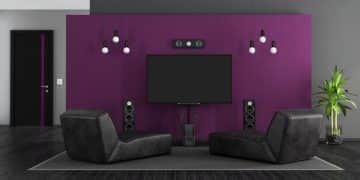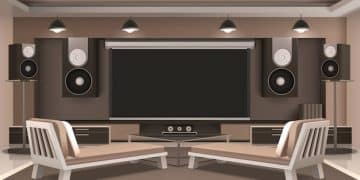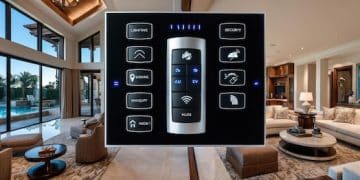Enhance Your Home Theater: Smart Lighting & Sound Automation
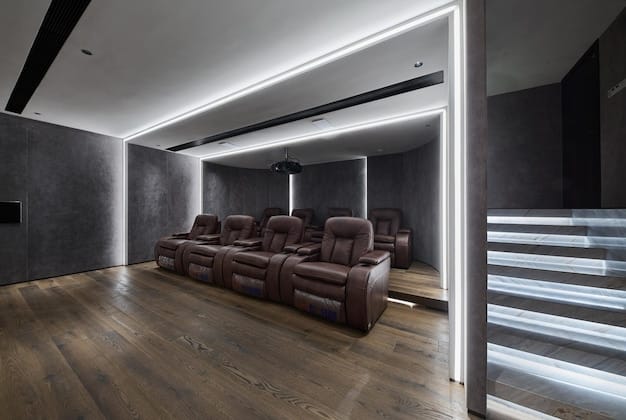
Enhance your home theater with smart lighting and sound automation by creating immersive experiences through integrated systems that optimize ambiance and acoustics for superior entertainment.
Transforming your viewing experience into something truly cinematic doesn’t require a complete overhaul. You can enhance your home theater with smart lighting and sound automation, creating an environment that’s both immersive and personalized.
Why Smart Lighting and Sound Matter for Your Home Theater
The key to a truly great home theater isn’t just the screen size or the sound system, it’s the overall ambiance. Smart lighting and sound automation play a crucial role in shaping that ambiance, taking your movie nights to the next level.
Imagine dimming the lights automatically as the movie starts or having the sound system adjust to the optimal levels for dialogue and action scenes. This level of control and customization is what smart technology brings to your home theater.
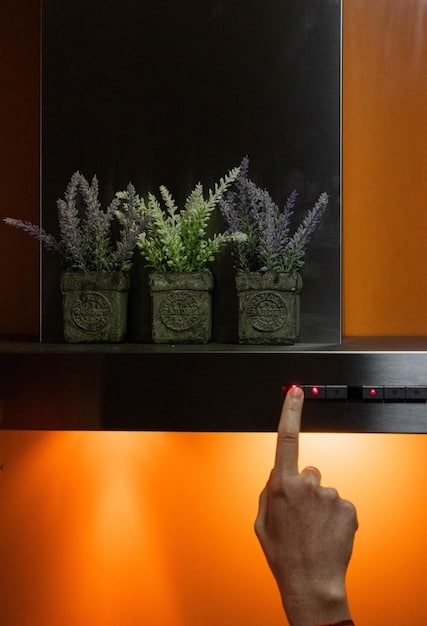
Creating the Perfect Atmosphere
Smart lighting allows you to personalize the room’s luminescence, setting the mood for whatever you’re watching. It creates an immersive environment that draws you deeper into the movie.
Optimizing Sound for Clarity
Automating your sound settings ensures you get the best possible audio experience. Adjust sound levels based on source and content, and calibrate speakers perfectly.
- Automated Dimming: Control your lights remotely to dim them at the perfect time.
- Customized Light Settings: Create lighting presets for different types of viewing.
- Multi-Zone Audio: Adjust the audio levels of different parts of your home theater separately.
In summary, smart lighting and sound automation greatly enhances the viewing experience. It enables you to control every detail, crafting a cinematic environment right in your home.
Choosing the Right Smart Lighting for Your Home Theater
Not all smart lighting solutions are created equal, especially when it comes to home theaters. Selecting the right type of lighting can significantly impact the viewing experience.
From ambient lighting that reduces eye strain to accent lights that highlight architectural features, there are numerous options available. Consider these factors when choosing smart lighting.
LED Strip Lights
LED strip lights are flexible and can be placed behind the TV, under seats, or along the ceiling to create a subtle, ambient glow. They offer a wide range of color options and are easy to control via smartphone apps or voice assistants.
Smart Bulbs
Smart bulbs replace traditional light bulbs and can be individually controlled. You can adjust brightness, color temperature, and even set schedules to dim or turn off automatically.
- Color Temperature: Choose bulbs with adjustable color temperature for warm or cool lighting.
- Brightness Control: Opt for bulbs that offer a wide range of brightness settings.
- Compatibility: Ensure the lights are compatible with your smart home ecosystem.
Selecting the right smart lighting involves assessing your specific needs and matching them with the capabilities of available products. Making the right choice will give you greater control over your viewing enjoyment.
Integrating Smart Sound Systems for Immersive Audio
A great picture deserves equally great sound. Integrating a smart sound system with your home theater can dramatically improve audio quality and create an immersive listening experience.
Smart sound systems come with features like voice control, multi-room audio, and automatic calibration. Pairing it with custom lighting will make your home theater phenomenal!

Wireless Surround Sound
Wireless surround sound systems eliminate the hassle of running cables throughout your home theater. They offer excellent sound quality and are easy to set up and configure.
Smart Soundbars
Smart soundbars are an all-in-one audio solution that combines speakers, amplifiers, and smart features. They are compact, easy to install, and offer impressive sound quality.
- Dolby Atmos Support: Look for systems that support Dolby Atmos for a more immersive experience.
- Voice Control: Choose systems that are compatible with voice assistants like Alexa or Google Assistant.
- Wireless Connectivity: Ensure the system supports Bluetooth or Wi-Fi for easy streaming.
By integrating a smart sound system, you’re crafting a viewing environment with incredible depth and clarity. You’ll be able to hear every explosion and whisper perfectly. It will truly enhance your experience in every way.
Setting Up Smart Home Automation for Your Home Theater
Smart home automation ties together all the components of your home theater, allowing you to control everything from a single app or voice command.
By integrating lighting, sound, and even your TV, you can create a seamless and personalized viewing experience. Here’s how.
Choosing a Smart Home Hub
The smart home hub acts as the central control point for all your devices. It allows you to connect and control your lighting, sound system, TV, and other smart devices from a single interface.
Creating Scenes and Routines
Smart home automation allows you to create scenes and routines that automate various tasks. For example, you can create a “Movie Night” scene that dims the lights, turns on the TV, and adjusts the sound levels with a single command.
- Voice Control: Use voice commands to control everything in your home theater.
- Remote Access: Control your home theater from anywhere using your smartphone.
- Scheduling: Set schedules to automatically turn on/off devices.
Setting up home automation elevates your home theater to a new level of convenience and customization. It enables you to control every aspect with a single tool, minimizing distractions.
Benefits of a Smart Home Theater System
Investing in a smart home theater system offers numerous benefits beyond just improved picture and sound quality.
From energy efficiency to increased convenience, here are some of the key advantages of upgrading to a smart home theater system.
Energy Efficiency
Smart lighting and sound systems can be programmed to turn off automatically when not in use, saving energy and reducing your electricity bill.
Enhanced Convenience
With voice control of remote management, you can easily adjust settings without leaving your seat. This is especially useful when hosting movie nights or watching sports with friends and family.
- Customizable Settings: Tailor the system to your preferences.
- Centralized Control: Manage everything from a single device.
- Improved Aesthetics: Modern smart devices enhance the visual allure of your home theater.
A well-designed smart home theater system merges convenience with efficiency, making it a valuable addition for any home. The benefits extend beyond the immediate viewing experience.
Troubleshooting Common Smart Home Theater Issues
Like any technology, smart home theater systems are susceptible to problems. Knowing how to troubleshoot common issues can save you time and frustration.
Here are some common problems and their solutions to help you maintain a smooth-running system.
Connectivity Issues
Ensure all your devices are connected to the same Wi-Fi network and that the network is stable. Restart your router and devices if you experience connectivity problems.
Compatibility Problems
Check that all your devices are compatible with your smart home hub. Update the firmware on your devices to resolve incompatibility issues.
- Software Updates: Keep all system software current.
- Customer Support: Don’t hesitate to contact manufacturers for help.
- Regular Maintenance: Clean and check peripherals periodically.
Troubleshooting is a crucial skill to develop when owning a smart home theater system. It ensures you can enjoy your investment fully without prolonged interruptions, keeping your experience smooth.
| Key Point | Brief Description |
|---|---|
| 💡 Smart Lighting | Adjustable LED strip lights and smart bulbs create the perfect ambiance for viewing. |
| 🔊 Smart Sound Systems | Wireless surround sound and smart soundbars deliver high-quality audio. |
| ⚙️ Home Automation | Centralized control with voice commands and automated scenes simplifies operation. |
| ⚡ Benefits | Energy efficiency, convenience, and enhanced aesthetics improve the viewing experience. |
Frequently Asked Questions
▼
Smart lighting provides adjustable brightness, color temperature, and automated dimming, enhancing the viewing experience by reducing eye strain and setting the perfect ambiance.
▼
Smart sound systems offer wireless surround sound, voice control, Dolby Atmos support, and multi-room audio options, delivering immersive and high-quality audio experiences.
▼
A smart home hub is a central control point that connects all your smart devices, allowing you to manage lighting, sound, and other devices from a single interface, streamlining operation.
▼
Ensure all devices are connected to the same Wi-Fi network, restart your router and devices, and check for device compatibility to resolve connectivity issues effectively.
▼
Yes, smart lighting and sound systems can be programmed to turn off automatically when not in use, saving energy and reducing your electricity bill, enhancing overall efficiency.
Conclusion
By integrating smart lighting and sound automation into your home theater, you’re not just watching movies; you’re creating an immersive and personalized entertainment experience. From automated dimming to crystal-clear audio, these technologies bring convenience, energy efficiency, and unparalleled viewing pleasure to your home. Embrace the future of home entertainment and transform your theater today.
